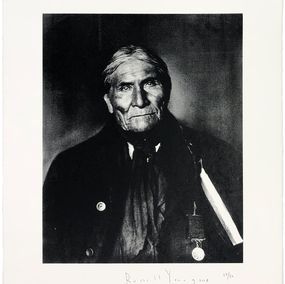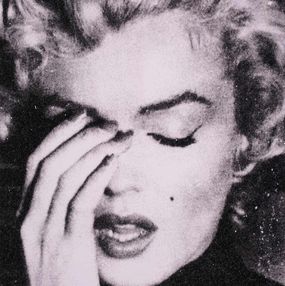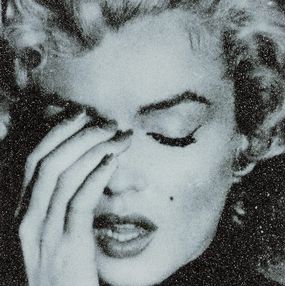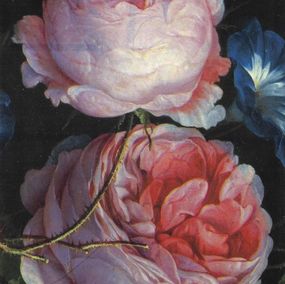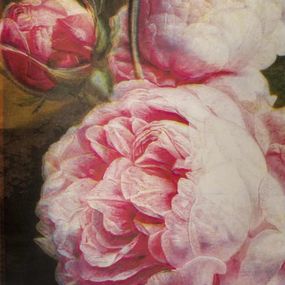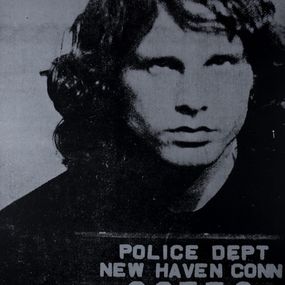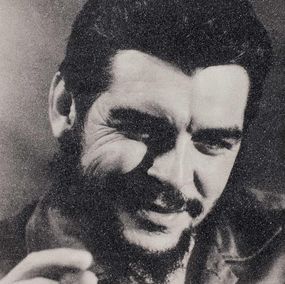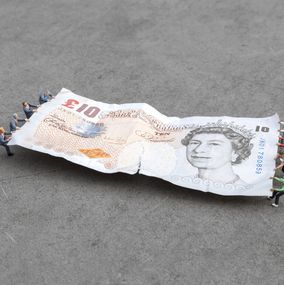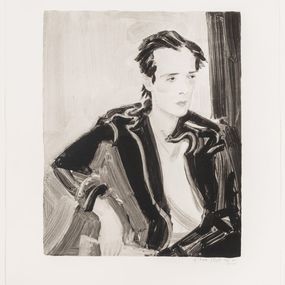
Marilyn crying (Fire red),
2019
Russell Young
Painting : acrylic, Screen Print, diamond dust
66 x 50.8 x 4 cm 26 x 20 x 1.6 inch
Second NOT DISPLAYED BLUR TEXT
Free returns within 14 days
Authenticity guaranteed
Learn moreSecure payment
About the artwork
Type
Unique work
Signature
Hand-signed by artist
Authenticity
Sold with certificate of Authenticity from the gallery
Invoice from the gallery
Dimensions cm • inch
66 x 50.8 x 4 cm 26 x 20 x 1.6 inch Height x Width x Depth
Support
Framing
Not framed
Artwork sold in perfect condition
Artwork location: Germany
Russell Young is an English artist (*1959) who works with iconic silkscreens showing portraits of celebrities. He imitates Andy Warhol’s way of printing. His “anti-celebrity” portraits are a reaction to his earlier life. He began his career as a celebrity photographer and had his breakthrough with the shooting for George Michael’s album Faith.
His “anti-celebrity” portraits are a reaction to his former life. He began his career as a celebrity photographer and had his breakthrough shooting for George Micheal’s album Faith.
Russell Young was born in Yorkshire in 1959, where he was immediately put into foster care and then into a nunnery and adopted before he was a year old. No one knew for sure who his birth parents were, although there were rumors that his mother was fourteen and his father was from Italy. In northern England, he spent much of his time moving from town to town, living an isolated life. It was here that Russell Young took his first photographs of birds on the lawn, only for the film to come back so darkly developed that he could barely make out the birds. Like those first photographs, Russell Young’s life evolved with areas blurred by abandonment. The lack of a personal or even shared history left him free to explore dreams and fantasies of sometimes better, sometimes harder worlds. This longing has led to a body of work that is an uncompromising, intimate love letter addressed to these vastnesses that prove with each inscription to be rich, wild frontiers.
With few prospects other than working in factory towns, Russell Young lied about his birth year to attend art school at the age of fifteen. Had he not done so, he most likely would have moved to the streets of London and died. Five years later, Russell Young moved to the capital and attracted the attention of photographer Christos Raftopoulos, whom he assisted for several years. Raftopoulos introduced Young to another side of himself, built him his own darkroom, took him to the opera, showed him the limits of his life and did not need to restrict him or his work. During this time, still raw in nature and occasionally homeless, he photographed the early performances of Bauhaus, R.E.M. and The Smiths. His innate eye for movement led him to photo shoots for magazines and eventually his first record cover for George Michael’s 1986 album Faith.
Russell Young continued to photograph celebrities and shoot music videos, which eventually led him to the United States. The rock star aesthetic he brandished in his photographs lent itself to his earliest screen prints, which followed in the 2000s. His first series, Pig Portraits, shown in Los Angeles in 2003, collected the infamous mug shots (real and staged) of celebrities awash in fame and monochrome, but also restrained because of their actions. In his subsequent series, Dirty Pretty Things, he began to incorporate his popular use of diamond dust into his images. The glamorous shots of cultural icons glittering in powdered diamonds embodied the desires and aspirations of their eras.
In the summer of 2009, Russell Young headed to the Greek island of Ithaca. Raftopoulos, who owned a house there, invited him to stay. The island served as a refuge for him. It led Russell Young, leaving behind his past and the expectations of his work on the shores of the mainland, to reclaim the sense of isolation that had haunted him all his life. There, in the midst of ancient olive groves, he soaked himself in goat’s blood obtained from a local butcher and pressed his body against linen. It was a monstrous performance, intended for no one but himself. Like a blasphemous reinterpretation of the Shroud of Turin, this wild and highly personal act marked a seminal turning point. It began what would become an ongoing and visceral conversation between his body, his memory, and the natural world. However, that conversation was abruptly cut short the following year when Young contracted the H1N1 virus, which put him in a coma for over a week. Russell Young nearly died. When he regained consciousness, he had to learn to read and write again, and he had forgotten the color green. When one of his children brought him a book of animals, he could hardly believe that polar bears actually existed on our planet.
What followed from Russell Young’s illness is the maturation of this conversation and the preoccupation with a central dilemma: the precise edge where youthful wonder turns to violent truth. In his first series of paintings after surviving his illness, Young pushed canvases into pools of red shellac, letting the resin drip, smear, and splatter like wounds. In Helter Skelter, he repeatedly silkscreened images from the Rolling Stones’ Free Concert at Altamont to abstraction, reproducing the infernal, disorienting frenzy that ended with the death of Meredith Hunter and the era of free love altogether. The counterculture of Young’s youth, once a source of inspiration, was now also a source of trauma. In its wake, he even left his own boot prints. A year later, in his series Only Anarchists are Pretty, Russell Young cut out pornographic images of bound women and arranged them like the brutal machinations of a mechanic lining the walls of his garage with pin-ups. These crowded arrangements were given the names of the council seats in northern England he remembered, places like Thorntree and The Lache, which once threatened to trap him.
Russell Young’s ongoing series, The West, pierces these claustrophobic visions for more realms. The West continues to tap into our most primal instincts, as well as our grandest dreams. The series features curios, knickknacks, heirlooms, and fantasies of its own world built within the larger framework of American drama. The spaghetti westerns he watched in his youth, NASCAR racers before they were safely regulated, California girls, Hawaiian surf photography of the big waves of the ’70s, the Marlboro cowboy before he was commercialized into oblivion, Native American chiefs before they, too, were nearly driven into oblivion – all debut in Young’s quest to confront and question the idealization of American history. Lately, Young has been piecing together his silkscreens, reminiscent of the classic anamorphic widescreen of Western films, to pay homage and also expose the artificiality of our dreams. The breadth of this ever-expanding series is matched only by Young’s impulse to venture into the deserts, forests, and oceans of America to go as far west as possible.
Russell Young lives with his family in a house he designed and built, nestled in the lush foothills of Southern California. When his mother visited him once, lounging near the pool under the imported palms and glimpsing the sublime from there, she remarked that none of it was real. Young people often leave this “paradise that is not real” behind and rough it out in the wilderness. He might spend days outside, sleeping under the highway, or swim into the ocean to watch the moon rise, or ignore evacuation orders and watch wildfires lick the walls of his house. He returns with industrial-strength felt from railroad tracks or giant pieces of charcoal washed ashore from other fires to experiment with in the retrofitted airplane hangar he uses as a studio. He revels in the diesel-like smell of oil and enamel that reminds him of the London Underground. Russell Young soaks his work in salt water to watch it rust. He strains so physically, tearing apart everything that is not real to expose himself.
Recently, Russell Young has begun to present his latest body of work, which similarly draws from his childhood, but also from a quieter strain of his usual efforts. Set in a melancholy blue, the silkscreens in one series feature turn-of-the-century photographs of animals that, if not already, will soon be extinct. In another, he enlarges paintings of flowers from the Dutch Golden Age to highlight the impossibilities of their unseasonal arrangements and hidden messages. Both the animals and the flowers are reminiscent of an earlier boy, when he was awestruck by things that seemed unattainable and would do anything to grasp their truth. He is interested in secrets, the ones we keep, the ones we share, and the ones we don’t want to be confronted with. A rose petal, on closer inspection, might be full of holes.
It is these holes that Russell Young’s work illuminates. The holes of trauma, of carnal desire, of memory and history. Through them he allows us to see vistas. In these vistas there are no expectations, no rules. He roams wherever he wants, always looking for a space where he can be free, experiment, investigate life and death. These are lands from which he resurrects dead dreams and designs alternative dreams. They are lands in which invented realities are spun out of the earnest hope of reinventing ourselves and ourselves.
Russell Young’s works have now passed through all the world’s major auction houses, including Sotheby’s, Christie’s, and Phillips.
About the seller
FRANK FLUEGEL GALERIE • Germany
Artsper seller since 2014
Vetted Seller
Top Seller
This seller rewards your purchases of multiple artworks
Imagine it at home

Discover more by the artist
Presentation
Russell Young was born in 1959 to an unwed mother and into the cold, wet, isolation of Northern England. He spent his first months passed from foster care to a nunnery and at four months, was adopted by Ken and Lesley Young. The new family migrated across the north. From an early age Young felt an outsider in this dark world. He was powerfully drawn to the idealized drama and warm comfort of the American dream. Everything American he came in contact with represented freedom, possibility and sun. Young hated school and by the age of 14 often skipped out entirely. He escaped to the football terraces with his father. He loved the chants and tough terrace culture. As many northern youths, he was born ripe into the Sex Pistols, Joy Division, New Order and the northern soul of the Wigan Casino.
He began to take photographs. He landed at the Chester Art College where he studied photography, film and graphic design under Jack Straw, who shaped Young's early development, presenting a never imagined path forward. His parents divorced. He continued on to Exeter Art College and to London where he couldn't find a job. After months on the streets he began assisting photographer, Christos Raftopoulos. Raftopoulos, an aesthete, took him under his wing and taught him to see a new world of light and sharp detail. Raftopoulos pushed Young to take on projects of his own.
He started at the live club shows of Bauhaus, R.E.M. and the Smiths. The photographs were exquisite and he quickly picked up work for magazines and eventually began sessions for the record companies. In 1986, he shot the 'Faith' sleeve for George Michael, launching him towards America and opportunity. He did portraits of Morrissey, Bjork, Springsteen, Dylan, New Order, Diana Ross, Paul Newman and many other celebrities. He began to direct music videos; one hundred during the glory days of MTV.
In 1992, Young moved to Hollywood. He met Finola Hughes, they married and life took shape for him in America. His career as a photographer and music video director was flourishing. He carved out the time and began to paint seriously. Young and Hughes moved to New York. In September 2000, he'd grown frustrated by the limits of the photograph and the commercial world around it. Hughes was seven months pregnant with their first son. He felt frozen and dead as a creative person. He went to Tuscany and he sat on a hill above a farm to meditate on becoming an artist.
Young returned to New York and rented a studio in Brooklyn and began a series of experiments he called, 'Combine Paintings'. He also started what he believed were clearly extensions of photography. He begins his series of 'Pig Portraits'. Young had spent his photographic career doing portraits of celebrities. He never felt he'd captured his subject as true and as powerfully as these new works. The answers to the questions he had of himself were in fact playing out in the 'Pig Portraits'. They attacked the nature of photography, portraiture and prickly nature of celebrity itself.
In 2003 he showed his first series of 'Pig Portraits' in Los Angeles. He was now a painter, an artist. The family moved back to California and built a house on the coast, 80 miles north of Los Angeles. Young built a studio on the compound and began working alone, focusing on the development of ideas and flying east to New York to work with his master printer and team.
Young pressed himself into this new method of action by reflection, using its forced structure to allow the freedom to follow streams of thought that would normally be cast aside in haste. This lead to powerful new work, eclectic in scope, never afraid to turn on itself. In 2007, he showed his Fame + Shame paintings in London. They were an exorcism, a gritty, bare 'pop-art cocktail' of America, seen through the eyes of the young man from the north of England, leading one through the glamour and glory to brutal chaos and brooding. Crying out, “shelve your western plans."
Young began to use diamond dust in 2007, pressing the crystals into the enamel of the paintings. He was drawn to the opulence of the light, shimmering off the multi-faceted glass. He hung the paintings from the trees of his California garden. At night the moon shone blue on the crystals. The images were lost in the abstract flicker of light only to once again, reclaim their place. In the monochrome paintings we recognize Marilyn Crying and Kurt Cobain. Then the light falls on the diamonds and the choir sings. He called them “Dirty Pretty Things" and seemed to assault the idea of even looking at pictures, turning the experience into chewing bubble gum.
In 2009 he began the “American Envy" paintings, revisiting some of his most iconic social signifiers, but going deeper into the eye of the storm, brilliantly walking us down the spiraling vortex of rebellion, hope, violence and madness towards the collision of dream and sacrifice. Elvis, JFK and Charles Manson are the chaperons.
In February 2010, Young was admitted to the Cottage Hospital in Santa Barbara, California and diagnosed with the H1N1 virus, the Swine Flu. Young endured an 8-day induced coma with doctors and loved ones skeptical of recovery. After a lengthy stay in hospital, Young emerged from his near-death experience with severe memory loss and an incredibly weak body. Little by little, he built back his strength and began examining his life and his surroundings in a whole new way. He says, “I left the hospital and I had to learn to breath, write, draw, think, and walk for the second time in my life."
During this process of recovery, Young began to explore the nature of trauma and its effect on both the individual and cultural psyche. Embracing and utilizing a new more visceral and animalistic process he attacks and dissects the imagery within the canvas. 2011 forced a seminal shift in his work. He began to work free from the domestication of art, like a feral boy, filled with a new, rough energy of violence, sex and power. First, in his magnificent, “Helter Skelter" paintings he danced with this energy. He cast away a century of 'modern pictures' and produced a stunning series, where we don't look from afar but are surrounded in chaos and mayhem. These are not pictures of the murder of Meredith Hunter at Altamont; they used the picture as the brush to paint the 'Helter Skelter'.
With his next series, “Isolation", Young forced shift again, harder. In an act of Burroughs, he 'cuts up' the glossy files of bound women and forces them onto large, unimaginable orgies of claustrophobic assemblage. With enormous screens, he prints each into her place; episode in multitude, again and again. The sultry, luscious black enamel is made rough and dirty by the act. The room has gotten smaller; we are surrounded by hard, dark, unapologetic fantasy. The women ask if they are art. The room fills with the symphonic screams of pleasure both beautiful and brutal. The paintings are named for the council flats of Northern England; Nant Peris, The Gorbals, Thorntree. Their names twist the paintings from sex to the screams of children, fighting for a way out of the dark. Akin to Joy Division, a name taken from the nazi camp whorehouse, where the officers found pleasure in their prize.
Young continues to challenge and reinvent himself using bold, forceful checks and assaults on his own systems to find new ways of expression. He uses themes, still with him from boyhood, to express feelings of isolation, alienation, entrapment and the marginalized dreams of an outsider fighting for a way into the light and expression. His work has been shown in London, Paris, Berlin, Tokyo, Singapore, New York, Detroit, Miami and Los Angeles.
Russell Young lives and works on the California coast and in Brooklyn, New York.
MUSEUM EXHIBITIONS
2018-2019
RUSSELL YOUNG – SUPERSTAR
Modern Art Museum, Shanghai
2015
FOREVER YOUNG: A Retrospective
Polk Museum of Art, Lakeland, FL
2012
RUSSELL YOUNG: A Retrospective
Goss-Michael Foundation, Dallas
COLLECTIONS
Albertina Museum, Vienna
Carlo Ancelotti, Madrid
Jennifer Aniston, Los Angeles
Kate Beckinsale, Los Angeles
The Benetton Foundation, Treviso, Italy
David Bowie, New York
The Core Club, New York
Cornell Art Museum, Florida
Beth DeWoody, New York
Drake, Hidden Hills, California
Kirsten Dunst, Los Angeles
The Getty Collection, Los Angeles
Goss-Michael Foundation, Dallas
Laurence Graff, New York
David Hockney, Los Angeles
Istanbul Museum of Modern Art, Istanbul
Marc Jacobs, New York
Kris Jenner, Los Angeles
Angelina Jolie, Los Angeles
Khloe Kardashian, Los Angeles
Floyd Mayweather, Las Vegas
The Mint Museum, Charlotte, North Carolina
Mohammed VI of Morocco, Rabat
The Estate of Marilyn Monroe, New York
Kate Moss, London
Multimedia Art Museum, Moscow
Elon Musk, Los Angeles
Mark Zuckerberg, Palo Alto
Sharon Osbourne, Los Angeles
John Paulson, New York
Crown Prince Pavlos of Greece, Athens
Joaquin Phoenix, Los Angeles
Brad Pitt, Los Angeles
The Polk Museum of Art, Florida
The Qatari Royal Family, Doha
Lou Reed, New York
Aby Rosen, New York
The Saatchi Collection, London
Paul Smith, London
Daisy Soros, New York
Elizabeth Taylor, Los Angeles
Kanye West, Los Angeles
White House Collection, Washington, DC
More works from FRANK FLUEGEL GALERIE
This seller offers discount when you purchase multiple artworks!
Artsper delivers internationally. The list of countries is available in the first step of your cart.
If your country is not listed contact us at [email protected] and we will see what we can do.
Note that Customs fees may apply for works shipped internationally. This is indicated in the first step of the shopping cart.
You can choose a delivery address different from the billing address. Make sure that a trusted person is present to receive the work if you cannot be there.
Have you purchased a painting, sculpture or work on paper?
Find our expert advice for the conservation and promotion of your works in the articles below:
Artsper offers you access to more than 200,000 works of contemporary art from 2,000 partner galleries. Our team of experts carefully selects galleries to guarantee the quality and originality of the works.
You benefit from:
-
Works at gallery price
-
Return within 14 days, regardless of your location
-
Easy resale of the work purchased on Artsper
-
Personalized research tools (selection and tailor-made universe)
Our customer service is available for any assistance.
At Artsper, our mission is to allow you to collect works of art with complete peace of mind. Discover the protections we offer at every stage of your shopping experience.
Buy works from top galleries
We work in close collaboration with carefully selected art galleries. Each seller on Artsper is carefully examined and approved by our team, thus ensuring compliance with our code of ethics. You therefore have the assurance of purchasing authentic, high-quality works.
Total transparency: you know what you are buying
Before being posted online, all artwork on Artsper is reviewed and validated by our moderation team. You can browse with complete peace of mind, knowing that each piece meets our criteria of excellence.
Personalized support: our experts at your service
Our team of contemporary art experts is available by phone or email to answer all your questions. Whether you want advice on a work or a tailor-made selection to enrich your collection, we are here to support you.
Resell your works with ease
If you have purchased a work on Artsper and wish to resell it, we offer you a dedicated platform to relist it. To find out more, click here.
Make offers with Artsper: negotiate like in a gallery
You have the possibility to propose a price for certain works, just like in a gallery. This feature allows you to initiate discussions and potentially acquire your coins at advantageous prices.
Get help with your negotiations
Our team will negotiate for you and inform you as soon as the best offer is obtained. Do not hesitate to call on our expertise to ensure a transaction at the best price.
Order securely
Artsper satisfaction assurance
We want you to be completely satisfied with your purchase. If the work you receive is not to your liking, you have 14 days to return it free of charge, and you will be refunded in full, whatever the reason.
Secure payment with Artsper partners
All credit card payments are processed by Paybox, the world leader in payment solutions. Thanks to their strict security standards, you can transact with confidence.
Problem Support
In the rare event that an artwork arrives damaged or not as described, we are here to help. Whether for a return, refund, restoration or exchange, our team will support you throughout the process and will ensure that we find the solution best suited to your situation.
Conditions to benefit from Artsper protections:
-
Use one of the payment methods available on Artsper for your order.
-
Report any problems within one week of receiving the work.
-
Provide required photographic evidence (including original artwork and packaging).
Artsper guarantees cover the following cases:
-
The received work lacks a described characteristic (for example, a signature or frame).
-
The artwork has significant differences from its description (e.g. color variation).
-
The work is damaged upon receipt.
-
The work is lost or damaged by the carrier.
-
Delivery is significantly delayed.
With Artsper, you collect with complete peace of mind.







